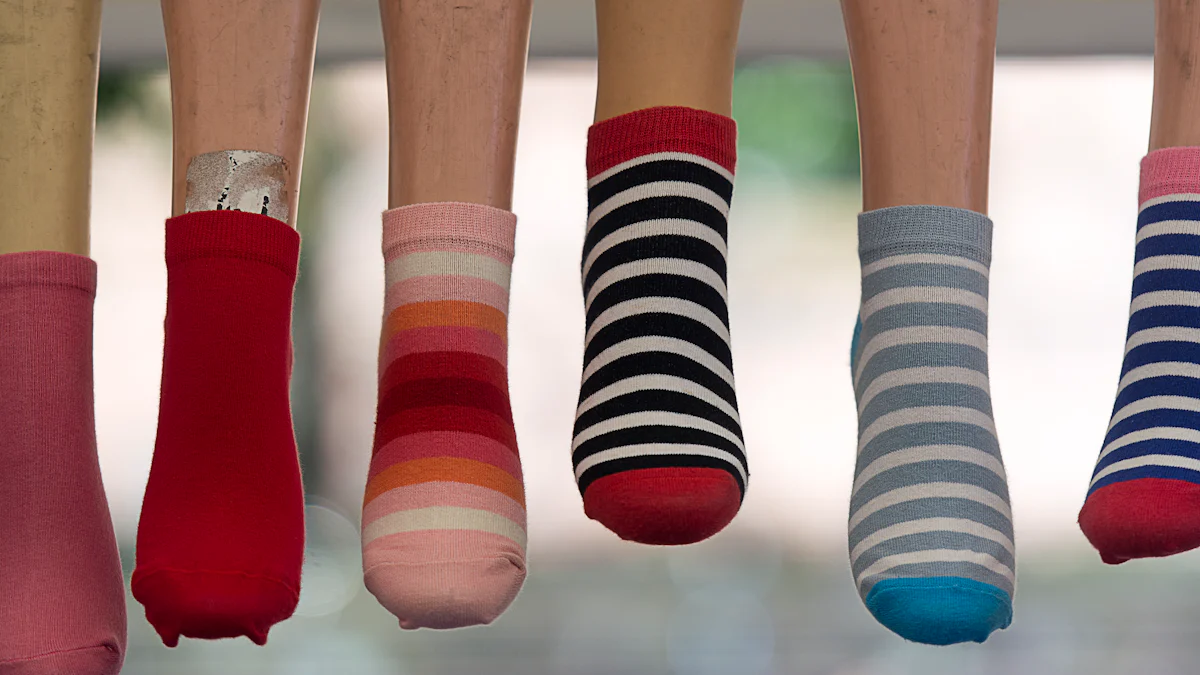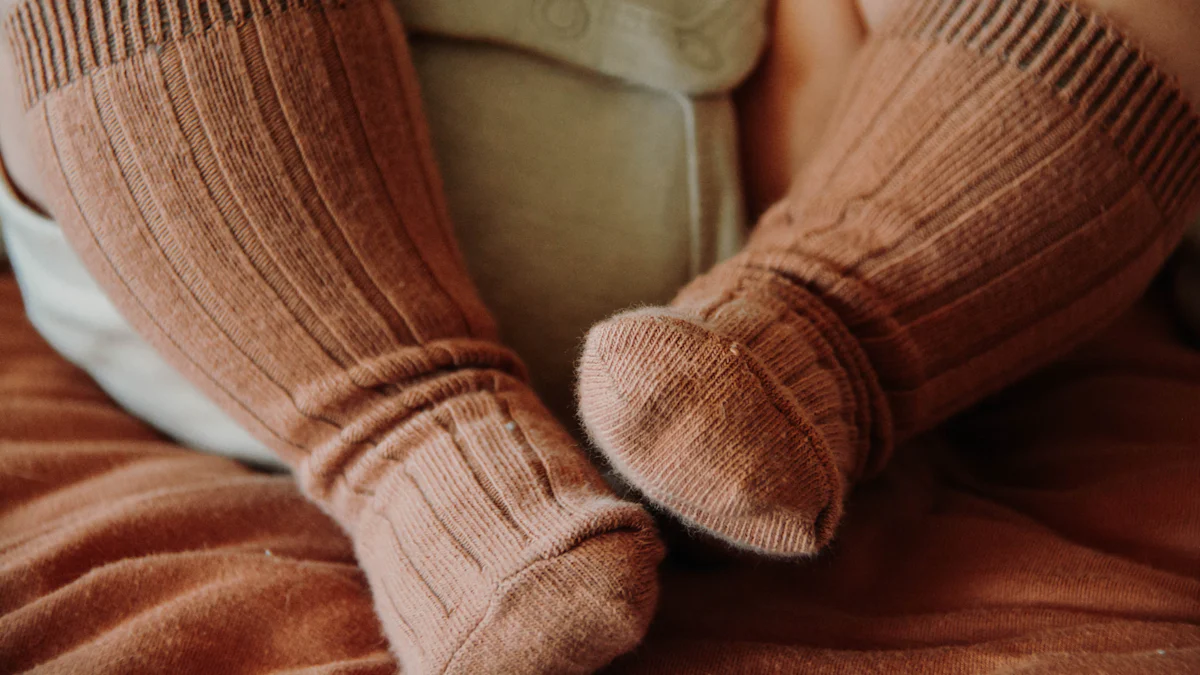
Choosing the right socks plays a crucial role in foot health and comfort. 100 percent cotton socks men’s offer a natural, breathable option, while blended fabrics combine various materials for enhanced performance. This showdown aims to compare and contrast these two popular choices, helping readers make informed decisions about their sock preferences.
Material Composition
100% Cotton
Natural Fiber Characteristics
100 percent cotton socks men’s are made from natural fibers. These fibers offer a soft and breathable texture. The natural composition allows for excellent ventilation. This helps keep feet cool and dry. Cotton fibers absorb moisture well, reducing the risk of foot odor.
Common Uses and Popularity
100 percent cotton socks men’s are popular for casual wear. People prefer them for their softness and comfort. These socks are ideal for light exercise and everyday activities. Many choose them for office environments due to their warmth and comfort. The natural fibers make them gentle on the skin, which is beneficial for those with sensitive skin.
Blended Fabric
Composition and Types of Blends
Blended fabrics combine various materials. Common blends include cotton-polyester and cotton-spandex. These blends balance comfort, durability, and breathability. Cotton-polyester blends mix the softness of cotton with the durability of polyester. Cotton-spandex blends add stretch for a better fit.
Common Uses and Popularity
Blended fabric socks are versatile. They suit both casual and active wear. The combination of materials enhances performance. Cotton-polyester blends are great for moisture control and durability. Cotton-spandex blends provide a snug fit, making them ideal for sports. Many people prefer blended fabrics for their balanced properties.
Comfort and Fit

100% Cotton
Softness and Breathability
100 percent cotton socks men’s provide exceptional softness. The natural fibers create a gentle texture against the skin. This makes these socks ideal for those with sensitive skin. Cotton’s breathability allows air to circulate freely. This helps keep feet cool and dry. Moisture absorption is another key feature. Cotton fibers absorb sweat, reducing the risk of foot odor.
Fit and Stretch
100 percent cotton socks men’s offer a comfortable fit. The natural fibers conform to the shape of the foot. This provides a snug yet comfortable feel. However, pure cotton lacks elasticity. Over time, the socks may lose their shape. Frequent washing can also affect the fit. For a better fit, some manufacturers blend cotton with elastic materials.
Blended Fabric
Softness and Breathability
Blended fabric socks combine the best of multiple materials. Cotton-polyester blends offer a balance of softness and durability. Cotton-spandex blends add stretch for a better fit. These blends maintain a good level of breathability. Cotton fibers in the blend allow for ventilation. Synthetic fibers like polyester enhance moisture-wicking properties. This combination helps keep feet dry and comfortable.
Fit and Stretch
Blended fabric socks excel in fit and stretch. The addition of spandex or elastane improves elasticity. This ensures a snug fit that adapts to foot movements. The socks retain their shape even after multiple washes. Cotton-polyester blends provide durability. This makes them suitable for both casual and active wear. The enhanced fit and stretch make these socks versatile.
Performance Attributes
Moisture Control
100% Cotton
100 percent cotton socks men’s excel in moisture absorption. The natural fibers absorb sweat effectively. This helps keep feet dry during light activities. However, cotton lacks moisture-wicking properties. Excessive sweating can lead to dampness and discomfort. Cotton socks may not be ideal for high-intensity activities.
Blended Fabric
Blended fabric socks offer superior moisture control. Cotton-polyester blends combine the best of both worlds. Cotton absorbs moisture, while polyester wicks it away. This keeps feet dry and comfortable. Cotton-spandex blends also provide moisture-wicking benefits. These socks are suitable for both casual and active wear. The combination of materials enhances overall performance.
Durability
100% Cotton
100 percent cotton socks men’s provide a soft and comfortable feel. However, pure cotton lacks durability. Frequent washing can cause wear and tear. Cotton fibers may lose their shape over time. These socks are better suited for low-impact activities. For longer-lasting options, consider blended fabrics.
Blended Fabric
Blended fabric socks excel in durability. Cotton-polyester blends offer strength and resilience. Polyester fibers enhance the lifespan of the socks. Cotton-spandex blends add stretch without compromising durability. These socks retain their shape even after multiple washes. The combination of materials ensures long-lasting performance. Blended fabrics are ideal for both casual and active wear.
Maintenance and Care
100% Cotton
100 percent cotton socks men’s require gentle care. Washing in cold water helps maintain the fabric’s integrity. Avoid using harsh detergents to prevent damage. Air drying is recommended to preserve the shape. Frequent washing may still cause some wear and tear. Proper care can extend the lifespan of cotton socks.
Blended Fabric
Blended fabric socks are easier to maintain. Cotton-polyester blends withstand regular washing. The addition of synthetic fibers enhances durability. Cotton-spandex blends also hold up well in the wash. These socks retain their shape and elasticity. Machine washing and drying are generally safe. Blended fabrics offer convenience and longevity.
Environmental Impact

100% Cotton
Sustainability and Eco-Friendliness
100 percent cotton socks men’s offer significant sustainability benefits. Cotton, being a natural fiber, is biodegradable. This means that cotton socks decompose naturally, reducing landfill waste. Organic cotton options further enhance eco-friendliness. Organic farming practices avoid harmful pesticides and fertilizers, promoting soil health and biodiversity. Consumers increasingly prefer sustainable materials, driving market growth for eco-friendly socks.
Production Impact
The production of 100 percent cotton socks men’s involves several environmental considerations. Conventional cotton farming requires substantial water usage. This can strain local water resources. However, organic cotton farming uses less water and avoids synthetic chemicals. The production process for cotton socks also generates fewer greenhouse gas emissions compared to synthetic fibers. Despite these advantages, the overall environmental impact depends on farming practices and manufacturing processes.
Blended Fabric
Sustainability and Eco-Friendliness
Blended fabric socks present a mixed picture in terms of sustainability. Common blends include cotton-polyester and cotton-spandex. Polyester, a petroleum-based fiber, is less biodegradable than cotton. This contributes to long-term environmental pollution. However, recycled polyester offers a more sustainable alternative. Many manufacturers now use recycled materials to reduce environmental impact. Recycled polyester helps divert plastic waste from landfills and oceans.
Production Impact
The production of blended fabric socks involves both benefits and drawbacks. The inclusion of synthetic fibers like polyester enhances durability, reducing the need for frequent replacements. This can lower overall resource consumption. However, the production of synthetic fibers involves energy-intensive processes. These processes generate higher greenhouse gas emissions compared to natural fibers. Manufacturers are increasingly adopting sustainable practices, such as using recycled materials and improving energy efficiency, to mitigate these impacts.
- Recap of Key Points:
- 100% Cotton Socks: Soft, breathable, and ideal for casual wear. However, less durable and not suitable for high-intensity activities.
- Blended Fabric Socks: Combine comfort with durability and moisture-wicking properties. Suitable for both casual and active wear.
- Final Thoughts:
- For everyday comfort and breathability, choose 100% cotton socks.
- For durability and moisture control, opt for blended fabric socks.
- Consider Personal Preferences:
- Evaluate your daily activities and foot care needs.
- Choose socks that align with your lifestyle and comfort preferences.
- Call to Action:
- Explore various sock options to find the perfect pair for your needs.
- Consider trying a blend of both materials for different occasions.

